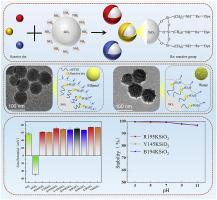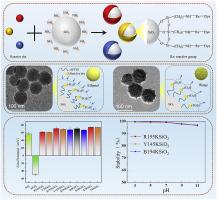Silicon-based nano pigment particles for sustainable textile printing and dyeing: enhanced dye utilization and reduced wastewater discharge
IF 10
1区 环境科学与生态学
Q1 ENGINEERING, ENVIRONMENTAL
引用次数: 0
Abstract
Enhancing dye utilization and reducing dye emissions are essential goals for the textile industry, achievable by immobilizing dyes on a carrier to minimize dye consumption and wastewater generation. This study introduces silicon-based nano pigment particles (SNPPs) synthesized by immobilizing reactive dyes onto silica nanospheres via (3-aminopropyl) triethoxysilane (APTES). The structure-property relationship between the reactive dye structure and the performance of SNPPs is systematically elucidated. SNPPs achieved adsorption rates exceeding 80 % for K-type reactive dyes (capacity >80 mg/g) and over 90 % for M-type, KN-type, and X-type dyes (capacities >110 mg/g). The particles exhibited high electronegativity (>-60 mV), excellent dispersibility, and stability, with bi-functional reactive dyes demonstrating superior performance due to enhanced covalent interactions. Application in cotton fabric printing and dyeing yielded vivid colors (color strength up to 10.37) and excellent fastness properties (rubbing: 3–4, washing: 4–5, light: 3–5 grades). Furthermore, cotton fabric dyed with recycled SNPPs showed consistent colorimetric performance and color fastness properties across five regeneration cycles. This innovation offers a scalable, eco-friendly solution for textile coloration, aligning with industrial sustainability goals.


可持续纺织印染用硅基纳米颜料颗粒:提高染料利用率,减少废水排放
提高染料利用率和减少染料排放是纺织工业的基本目标,可以通过将染料固定在载体上来最大限度地减少染料消耗和废水产生。本文介绍了通过(3-氨基丙基)三乙氧基硅烷(APTES)将活性染料固定在二氧化硅纳米球上合成的硅基纳米颜料颗粒(SNPPs)。系统地阐述了活性染料结构与SNPPs性能之间的结构-性能关系。SNPPs对k型活性染料(容量80 mg/g)的吸附率超过80%,对m型、kn型和x型染料(容量110 mg/g)的吸附率超过90%。该粒子具有高电负性(>-60 mV),优异的分散性和稳定性,双功能活性染料由于增强的共价相互作用而表现出优越的性能。应用于棉织物印染,颜色鲜艳(色强度可达10.37),牢度性能优异(摩擦:3-4级,洗涤:4-5级,光:3-5级)。此外,用再生SNPPs染色的棉织物在5个再生循环中表现出一致的比色性能和色牢度性能。这项创新为纺织品着色提供了一种可扩展的、环保的解决方案,与工业可持续发展目标保持一致。
本文章由计算机程序翻译,如有差异,请以英文原文为准。
求助全文
约1分钟内获得全文
求助全文
来源期刊

Journal of Cleaner Production
环境科学-工程:环境
CiteScore
20.40
自引率
9.00%
发文量
4720
审稿时长
111 days
期刊介绍:
The Journal of Cleaner Production is an international, transdisciplinary journal that addresses and discusses theoretical and practical Cleaner Production, Environmental, and Sustainability issues. It aims to help societies become more sustainable by focusing on the concept of 'Cleaner Production', which aims at preventing waste production and increasing efficiencies in energy, water, resources, and human capital use. The journal serves as a platform for corporations, governments, education institutions, regions, and societies to engage in discussions and research related to Cleaner Production, environmental, and sustainability practices.
 求助内容:
求助内容: 应助结果提醒方式:
应助结果提醒方式:


